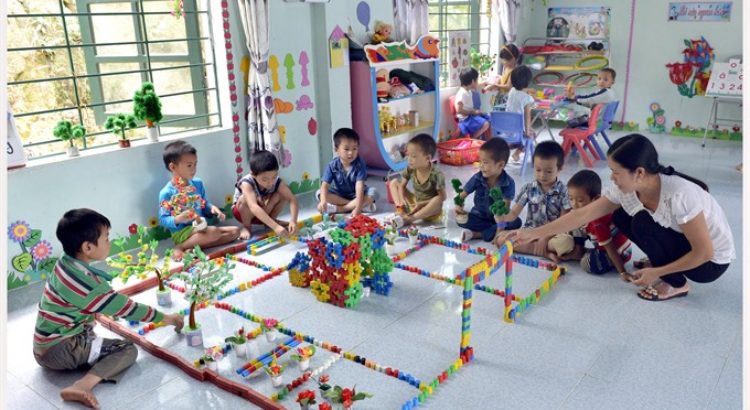Africa/ Uganda/ 11.12.2018/By: Lawrence Mulondo/ Source: www.newvision.co.ug.
Among the other sectors Save the children is championing in is Health and Nutrition, Child poverty, Child protection, Childs rights and governance.
Save the Children has urged the Ministry of Education to invest more in Early Childhood Development (ECD) in order to have quality children joining primary schools.
In an education Act of 2008, the government recognized pre-primary education as the first stage of education for all children below the age of eight.
The ECD education sector policy by the Ministry of Gender Labor and Social Development recognises four programs including day care Centres, Nursery schools, home care Centres and community Centres.
While attending the first day of the three day Save the Children partnership meeting at Royal Suits Bugolobi, partners agreed that a child that joins primary with an ECD background, has basic knowledge on literacy, giving them a good start.
Save the Children Head of Advocacy and Communications, Alun McDonald said children that attend ECDs have better social skills compared to those who did not attend.
“We recognize that ECD is critical in every child’s life as it determines the kind of adult they will be in future,” he said.
He pointed out that if children do not go through ECD, they find it difficult to learn skills in primary school.
McDonald said Uganda has made a lot of improvement in primary education due to the existence of Universal Primary Education (UPE).
He however said that the country is still weak in terms of ECD due to lack of enough public ECD Centres.
“Uganda has good policies on ECD, however they are not well implemented around the country especially in villages,” he said.
Statistics on ECD
According to Save the Children, only 13.4% of children in Uganda are enrolled in ECD/pre-primary.
Families with the highest income, 53% of children attend ECD, 21.6% of children from middle income families, and only 6.7% of children from the poorest families attend.
Save the Children says, there is also a big difference between urban and rural areas in terms of access to ECD as 53% of children in urban areas attend ECD, but only 19.5% in rural areas.
According to the 2017 UNICEF report 65 of the children between the age of 3 and 5 are developmentally on track in literacy, numerous and physical, social and emotional development.
According to the 2011 Ministry of Education statistics, ECD Centres distribution per region is as follows, Central region 783(33%), Eastern 554 (24%), North East106 (5%), North 354 (15%), South West 128 (5%), and West 436 (19%).
McDonald called on the government to sensitize the public more on the importance of ECD and also put in place a special budget for the construction of free ECD Centres in UPE schools.
The 2016 National ECD policy of Uganda has it that 80% of the ECD centers around the country are privately owned and financially out of reach from most Ugandans, adding that a few children benefit from institutionalized ECD centers leaving many toddlers to stay home with their parents of which many parents have are not experienced to offer ECD programs to their children.
While meeting a delegation from Canada on ECDs in January, the Minister of Higher Education, Dr. John Chrysostom Muyingo said: “Government realised that ECDs are very critical to the children’s education.
A review is being conducted by Curriculum Development Centre to provide an assessment that will fit with the demands of our educational market.”
Muyingo added that ECDs are the essential areas for child upbringing that introduce a child to learning new things in life.
He noted that it is at this stage that learners are introduced to writing, listening and also learning how to play with friends.
“In the past, the government was concentrated on funding primary education and Early Childhood Education (ECE) was left to the private sector and non-governmental organisations.
Save the Children involvement in ECD
Save the Children is currently constructing primary schools around the country that have an ECD complement. Last year, the NGO worked in 91 ECD Centres across Uganda.
McDonald revealed that as Save the Children commemorates 100 years in 2019, the country Directors will focus more on improving ECD in the countries where they are serving.
He said among the things they will be fostering is training ECD care givers and other necessities needed.
Partnerships
To implement their goals in the country, Save the Children works with partners Like New Vision in the Education sector and others.
Among the other sectors Save the children is championing in is Health and Nutrition, Child poverty, Child protection, Childs rights and governance.
Save the Children is partnering with New Vision to extend newspapers to children in different schools around the country like Karamoja, Nakasongola Nakaseke and others through the Norwegian Agency for Development Cooperation (NORAD) project.
The move is to inform children of what is going on in the country and the whole world as well as improve on their reading skills.
Challenges
McDonald said that limited funding is always a challenge to them as they extend services to children. He said their areas of operation are usually over whelming.
He added that the fact that Uganda is hosting a number of Refugees from different countries strains services offered by the organization in the areas where they are.
He however said the existence of refugees is also an opportunity as they contribute to the economy of the country.
Meeting objectives
Save the children partnership coordinator, Janet Nambuya said that they called for a meeting with their partners to share experiences and also to share areas where there is need for improvement.
Nabafu added that they called on partners to create a platform for reflection, learning, accountability and networking.
She added that in the meeting they are to disseminate the country strategic plan of 2019-2019.
Source of the notice: https://www.newvision.co.ug/new_vision/news/1491038/govt-urged-invest-childhood-development









 Users Today : 1
Users Today : 1 Total Users : 35460018
Total Users : 35460018 Views Today : 1
Views Today : 1 Total views : 3418632
Total views : 3418632